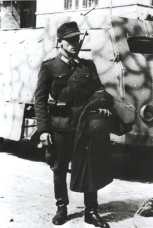 |
 |
 |
 |
 |
 |
 |
No study has been undertaken of the social background of the German and Austrian Belzec perpetrators. The following brief analysis is based on information disclosed at the trials of those men who served at the Belzec, Sobibor, and Treblinka camps and who were brought to trial as war criminals.
 |
|
Some of the Treblinka staff.
From left to right: Bredow, Mentz, Möller and
Hirtreiter. The
photo was taken in all probability under a straw umbrella at the
camp's zoo, built specially for the relaxation of the SS and which
was constructed by inmates.
|
The personnel who ran the camps and supervised the extermination activities were absolutely ordinary people. They were not assigned their tasks because of any exceptional qualities or characteristics. The anti-Semitism that festered within them was no doubt part of their milieu and was an accepted phenomenon among large segments of German society. Many of them were married, and most had no criminal record.
|
The Treblinka staff - although
mostly hardened by their euthanasia experience etc. - comprised of
ordinary Germans. An intrigueing fact was that they were entitled
to more leave than the ordinary conscript - at a rest home of T4,
specially reserved for Aktion Reinhard personnel only.
Here - as seen in this photo which includes Mentz (2nd right) from
Treblinka as well as other Treblinka guards such as Gentz, Sydow,
Boelitz and Miete - they relaxed from their grisly deathcamp tasks,
amongst the beautiful mountain scenery of Attersee lake, with their spouses and comrades.
|
 |
They had either volunteered to serve in the SS or had been drafted into its ranks. So it was not unusual that a man wore a SS uniform but received his salary from his real employer, the German police or Aktion T4, the Nazi euthanasia programme.
These men always carried out the murder of hundreds of thousands of men, women and children always loyally and unquestioningly. What is more, they constantly displayed initiative in trying to improve the extermination process. An integral aspect of their duties was that they were also to exhibit cruelty toward their victims, and many of them contributed their own ideas and innovations for various forms of torture that served to entertain them all. Under the Nazi regime, these perfectly ordinary people were turned into something extraordinarily inhuman. (Arad, p.24)
Source and pertinent material on the daily lives of these men in Belzec, on their personal feelings about the tasks that they carried out, and their relationship to their innocent victims is almost nonexistent.
Men, more than anxious to cover up their past, were not about to sit down and record their memoirs. Even at the trials at which some of them were forced to attest to their deeds, very little was brought out about their personal feelings and experiences. The primary sources on the behaviour of these perpetrators and their actual relationship to their victims are the testimonies of those who survived the camps, as well as some material and evidence that was submitted during their trials.
The prisoners used to nickname the various men in SS uniform, and these names were indicative of their reputations and activities in the camp. These nicknames were also a type of code to be used as a warning when a particular SS man appeared in a certain area of the camp. (Adapted from: Arad, p.180-181)
Taking the above restrictions on information into account, it is nevertheless possible to compile a reasonably comprehensive staff list of Belzec perpetrators.





















































